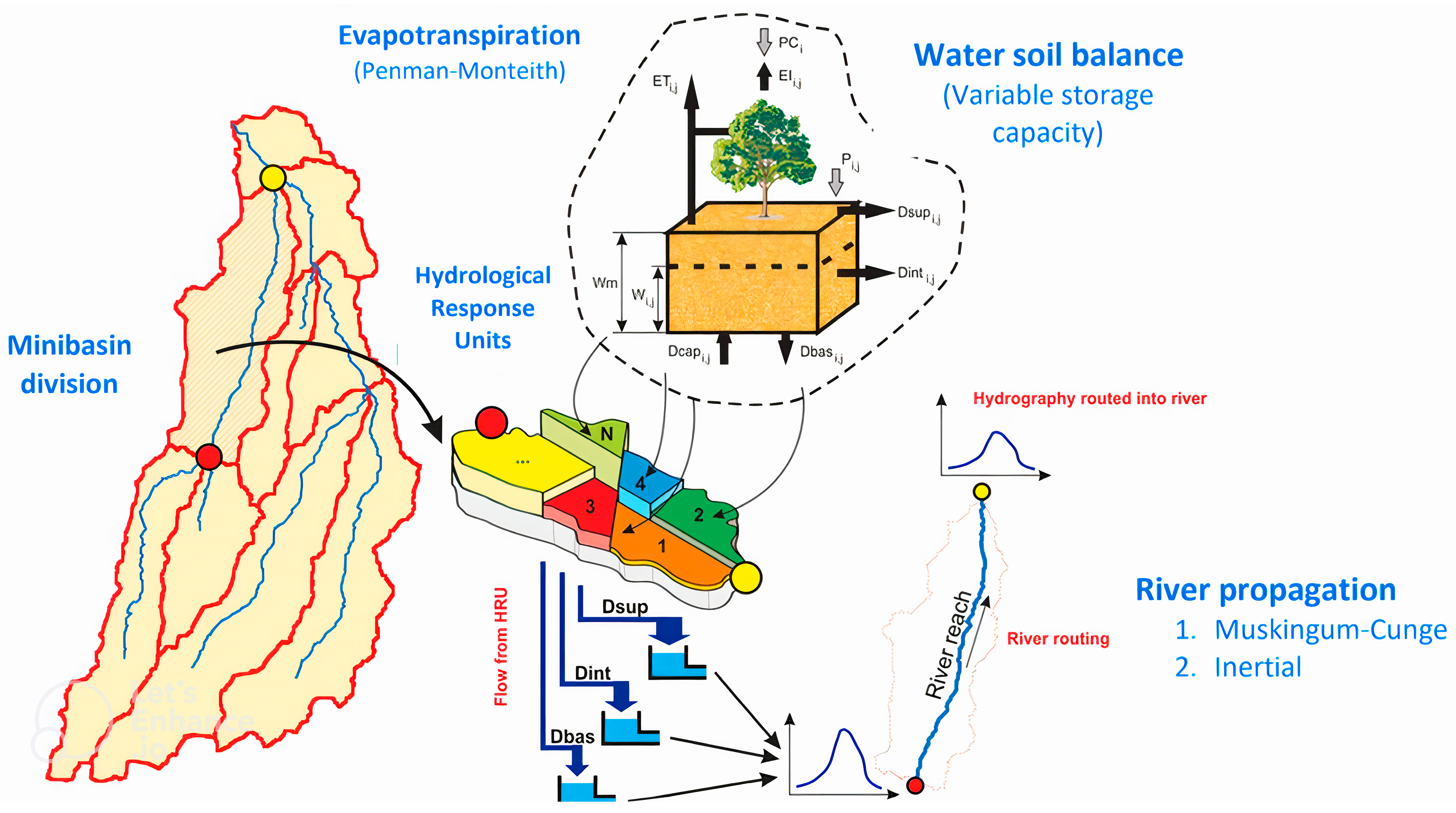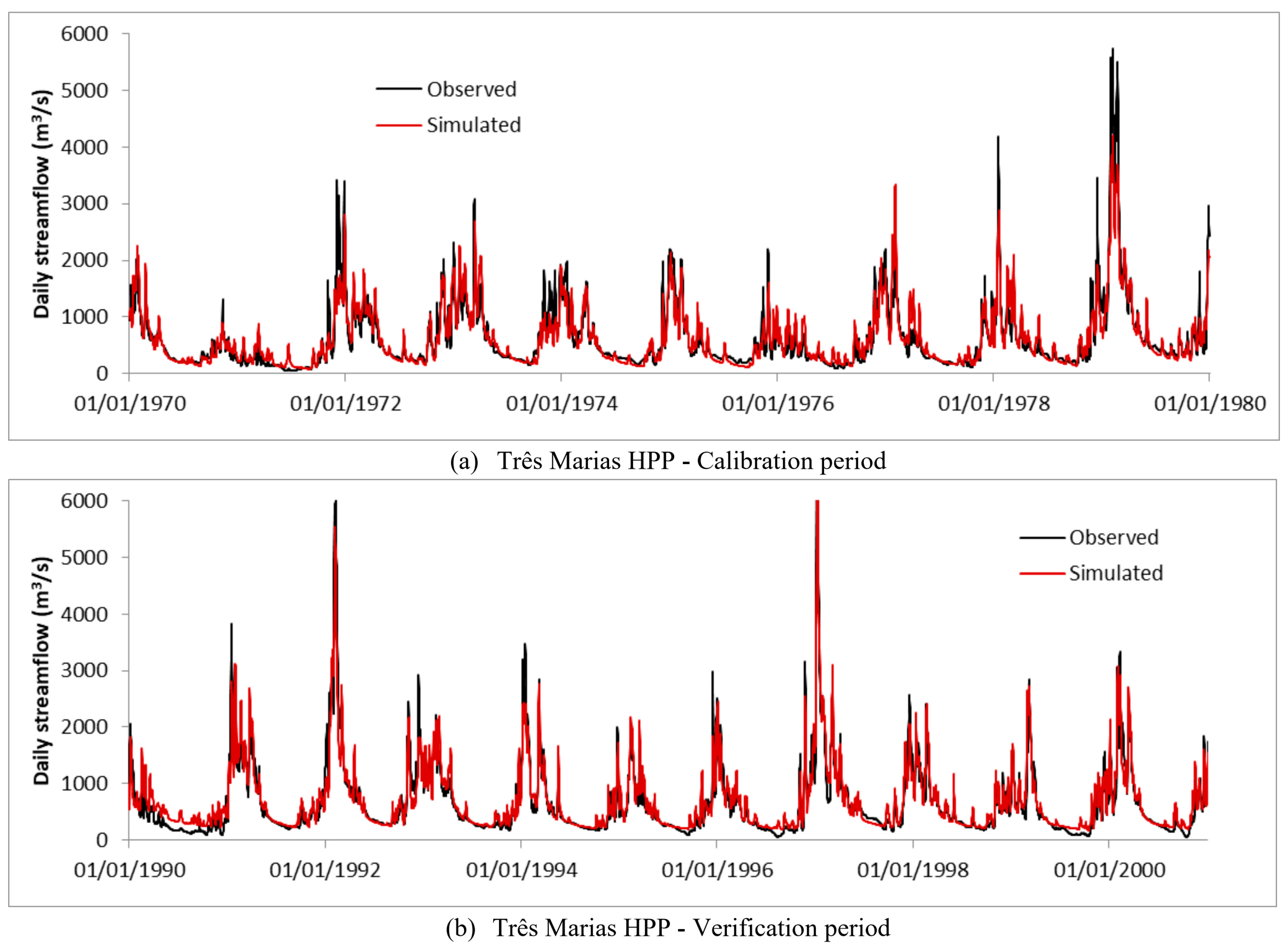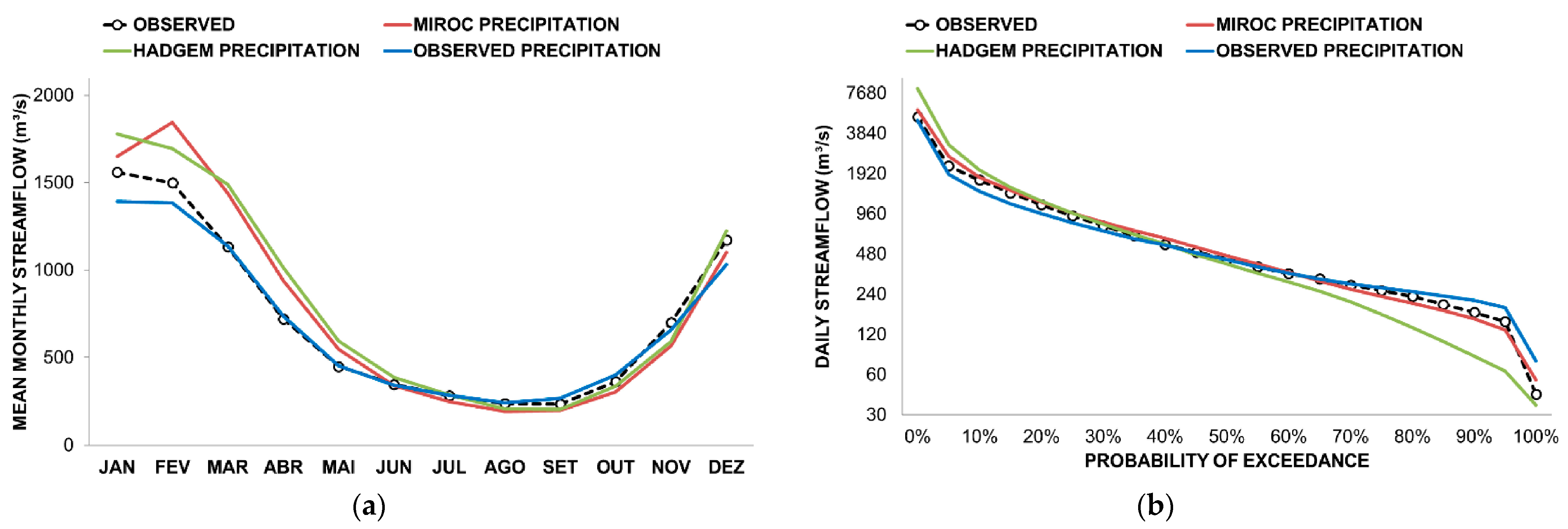Assessment of Climate Change Impact on Hydropower Generation: A Case Study for Três Marias Power Plant in Brazil
Abstract
:1. Introduction
2. Materials and Methods
2.1. Study Area and Selected Hydropower Plant
2.2. Hydrological Model
2.3. Climate Model
2.4. Stream Flow Projections
2.5. Determining the Impacts on Hydroelectric Generation
3. Results and Discussion
3.1. Hydrological Model Calibration
3.2. Projection of Stream Flows
3.3. Impacts on Power Generation
4. Conclusions
Supplementary Materials
Author Contributions
Funding
Data Availability Statement
Acknowledgments
Conflicts of Interest
References
- BIG/ANEEL—Banco de Informações de Geração da Agência Nacional de Energia Elétrica. Matriz de Energia Elétrica. 2017. Available online: http://www2.aneel.gov.br/aplicacoes/capacidadebrasil/capacidadebrasil.cfm (accessed on 10 May 2023).
- Chou, S.C.; Marengo, J.A.; Lyra, A.A.; Sueiro, G.; Pesquero, J.F.; Alves, L.M.; Kay, G.; Betts, R.; Chagas, D.J.; Gomes, J.L.; et al. Downscaling of South America present climate driven by 4-member HadCM3 runs. Clim. Dyn. 2012, 38, 635–653. [Google Scholar] [CrossRef]
- IPCC—Intergovernmental Panel on Climate Change. Climate Change 2014: Synthesis Report. Contribution of Working Groups I, II and III to the Fifth Assessment Report of the Intergovernmental Panel on Climate Change. 2014. Available online: https://archive.ipcc.ch/report/ar5/syr/ (accessed on 22 January 2022).
- Carvajal, P.E.; Anandarajah, G.; Mulugetta, Y.; Dessens, O. Assessing uncertainty of climate change impacts on long-term hydropower generation using the CMIP5 ensemble—The case of Ecuador. Clim. Change 2017, 144, 611–624. [Google Scholar] [CrossRef]
- Queiroz, A.R.; Lima, L.M.M.; Lima, J.W.M.; Silva, B.C.; Scianni, L.A. Climate change impacts in the energy supply of the Brazilian hydro-dominant power system. Renew. Energy 2016, 99, 379–389. [Google Scholar] [CrossRef]
- Schaeffer, R.; Szklo, A.S.; Lucena, A.F.P.; Borba, B.S.M.C.; Nogueira, L.P.P.; Fleming, F.P.; Troccoli, A.; Harrison, M.; Boulahya, M.S. Energy Sector Vulnerability to Climate Change: A review. Energy 2012, 38, 1–12. [Google Scholar] [CrossRef]
- Lima, J.W.M.; Collischonn, W.; Marengo, J.A. Efeitos das Mudanças Climáticas na Geração de Energia Elétrica; AES Tietê: São Paulo, Brazil, 2014. [Google Scholar]
- Tiezzi, R.O. Variabilidade Hidroclimatológica e seus Efeitos no Suprimento de Energia Elétrica do Sistema Interligado Nacional. Ph.D Thesis, State University of Campinas, Campinas, Brazil, 2015. [Google Scholar]
- Chang, K.H.; Kim, J.H.; Cho, C.H.; Bae, D.H.; Kim, J. Performance of a coupled atmosphere-streamflow prediction system at the Pyungchang River IHP basin. J. Hydrol. 2004, 288, 210–224. [Google Scholar] [CrossRef]
- Kopytkovskiy, M.; Geza, M.; Mccray, J.E. Climate-change Impacts on Water Resources and Hydropower Potential in the Upper Colorado River Basin. J. Hydrol. Reg. Stud. 2015, 3, 473–493. [Google Scholar] [CrossRef]
- Ribeiro Jr, L.U. Aprimoramento de um Instrumento de Gestão para Operação de Reservatórios Hidrelétricos com Usos Múltiplos sob Condições de Mudanças Climáticas: Estudo de caso UHE de Furnas. Ph.D Thesis, State University of Campinas, Campinas, Brazil, 2013. [Google Scholar]
- Fan, F.M.; Collischonn, W.; Meller, A.; Botelho, L.C.M. Ensemble streamflow forecasting experiments in a tropical basin: The São Francisco River case study. J. Hydrol. 2014, 519, 2906–2919. [Google Scholar] [CrossRef]
- Lucena, A.F.P.; Szklo, A.S.; Schaeffer, R.; Souza, R.R.; Borba, B.S.M.C.; Costa, I.V.L.; Pereira, A.O., Jr.; Cunha, S.H.F. The Vulnerability of Renewable Energy to Climate Change in Brazil. Energy Policy 2009, 37, 879–889. [Google Scholar] [CrossRef]
- Majone, B.; Villa, F.; Deidda, R.; Bellin, A. Impact of Climate Change and Water Use Policies on Hydropower Potential in the South-Eastern Alpine Region. Sci. Total Environ. 2016, 543, 965–980. [Google Scholar] [CrossRef]
- Maran, S.; Volonterio, M.; Gaudard, L. Climate Change Impacts on Hydropower in an Alpine Catchment. Environ. Sci. Policy 2014, 43, 15–25. [Google Scholar] [CrossRef]
- Mohor, G.S.; Rodriguez, D.A.; Tomasella, J.; Siqueira, J.L., Jr. Exploratory Analyses for the Assessment of Climate Change Impacts on the Energy Production in an Amazon Run-of-River Hydropower Plant. J. Hydrol. Reg. Stud. 2015, 4, 41–59. [Google Scholar] [CrossRef]
- Lucena, A.F.P. Proposta Metodológica para Avaliação da Vulnerabilidade às Mudanças Climáticas Globais no Setor Hidroelétrico. Ph.D Thesis, Federal University of Rio de Janeiro, Rio de Janeiro, Brazil, 2010. [Google Scholar]
- Santana, T.B. Impacto de Mudanças Climáticas sobre o Regime de Vazões e a Geração Hidrelétrica de Energia. Master’s Thesis, Federal University of Itajubá, Itajubá, Brazil, 2013. [Google Scholar]
- Stickler, C.M.; Coe, M.T.; Costa, M.H.; Nepstad, D.C.; McGrath, D.G.; Dias, L.C.P.; Rodrigues, H.O.; Soares-Filho, B.S. Dependence of hydropower energy on forests in the Amazon Basin at local and regional scales. Proc. Natl. Acad. Sci. USA 2013, 110, 9601–9606. [Google Scholar] [CrossRef]
- Siqueira Júnior, J.L.; Tomasella, J.; Rodriguez, D.A. Impacts of global and regional land-use and land-cover changes in thehydrological regime of the Madeira River basin. Clim. Change 2015, 129, 117–129. [Google Scholar] [CrossRef]
- Mendes, C.A.B.; Beluco, A.; Canales, F.A. Some important uncertainties related to climate change in projections for the Brazilian hydropower expansion in the Amazon. Energy 2017, 141, 123–138. [Google Scholar] [CrossRef]
- Von Randow, R.C.S.; Rodriguez, D.A.; Tomasella, J.; Aguiar, A.P.D.; Kruijt, B.; Kabat, P. Response of the river discharge in the Tocantins River Basin, Brazil, to environmental changes and the associated effects on the energy potential. Reg. Environ. Change 2019, 19, 193–204. [Google Scholar] [CrossRef]
- Nóbrega, M.T.; Collischonn, W.; Tucci, C.E.M.; da Paz, A.R. Uncertainty in climate change impacts on water resources in the Rio Grande Basin, Brazil. Hydrol. Earth Syst. Sci. 2011, 15, 585–595. [Google Scholar] [CrossRef]
- CBHSF—Comitê da Bacia Hidrográfica do Rio São Francisco. Plano de Recursos Hídricos da Bacia Hidrográfica do Rio São Francisco 2016–2025. 2015. Available online: http://cbhsaofrancisco.org.br/planoderecursoshidricos/wp-content/uploads/2015/04/RF3_24jan17.pdf (accessed on 5 May 2023).
- CEMIG—Companhia Energética de Minas Gerais. Energia da Gente—Informativo Mensal para os Empregados da CEMIG. Ano IX, n° 91, Agosto/Setembro. 2012. Available online: http://www.cemig.com.br/sites/Imprensa/pt-br/publicacoes/Documents/Energia%20da%20Gente/EG91_final.pdf (accessed on 7 May 2023).
- GAMA—Engenharia e Recursos Hídricos LTDA. Plano Diretor de Recursos Hídricos da Bacia Hidrográfica do Entorno da Represa Três Marias. R5—Relatório Final. Fase A—Diagnóstico Estratégico e Cenários de Desenvolvimento. Volume I—Meio Físico-Biótico e Disponibilidades Hídricas. 2015. Available online: http://www.repositorioigam.meioambiente.mg.gov.br/jspui/handle/123456789/654 (accessed on 28 May 2023).
- Collischonn, W.; Allasia, D.; Silva, B.C.; Tucci, C.E.M. The MGB-IPH model for large-scale rainfall-runoff modelling. Hydrol. Sci. J. 2007, 52, 878–895. [Google Scholar] [CrossRef]
- Fan, F.M.; Collischonn, W. Integração do Modelo MGB-IPH com Sistema de Informação Geográfinos Rev. Bras. De Recur. Hídricos 2014, 19, 243–254. [Google Scholar] [CrossRef]
- Silva, B.C. Previsão Hidroclimática de Vazão para a Bacia do rio São Francisco. Ph.D Thesis, Federal University of Rio Grande do Sul, Porto Alegre, Brazil, 2005. [Google Scholar]
- Collischonn, W. Simulação Hidrológica de Grandes Bacias. Ph.D Thesis, Federal University of Rio Grande do Sul, Porto Alegre, Brazil, 2001. [Google Scholar]
- ANA—Agência Nacional de Águas. Sistema de Informações Hidrológicas—HidroWeb. Available online: http://hidroweb.ana.gov.br/ (accessed on 10 January 2023).
- INMET—Instituto Nacional de Meteorologia. Banco de Dados Meteorológicos para Ensino e Pesquisa—BDMEP. 2023. Available online: http://www.inmet.gov.br/projetos/rede/pesquisa/ (accessed on 15 January 2023).
- ONS—Operador Nacional do Sistema Elétrico. Séries Históricas de Vazões. 2023. Available online: http://www.ons.org.br/operacao/vazoes_naturais.aspx (accessed on 10 January 2023).
- Chou, S.C.; Lyra, A.; Mourão, C.; Dereczynski, C.; Pilotto, I.; Gomes, J.; Bustamante, J.; Tavares, P.; Silva, A.; Rodrigues, D.; et al. Evaluation of the Eta Simulations Nested in Three Global Climate Models. Am. J. Clim. Change 2014, 3, 438–454. [Google Scholar] [CrossRef]
- Chou, S.C.; Lyra, A.; Mourão, C.; Dereczynski, C.; Pilotto, I.; Gomes, J.; Bustamante, J.; Tavares, P.; Silva, A.; Rodrigues, D.; et al. Assessment of Climate Change over South America under RCP 4.5 and 8.5 Downscaling Scenarios. Am. J. Clim. Change 2014, 3, 512–525. [Google Scholar] [CrossRef]
- Gellens, D.; Roulin, E. Streamflow response of Belgian catchments to IPCC change scenarios. J. Hydrol. 1998, 210, 242–258. [Google Scholar] [CrossRef]
- Bárdossy, A.; Pegram, G. Downscaling precipitation using regional climate models and circulation patterns toward hydrology. Water Resour. Res. 2011, 47, W04505. [Google Scholar] [CrossRef]
- Tucci, C.E.M. Hidrologia: Ciência e aplicação, 4th ed.; Editora da UFRGS: Porto Alegre, Brazil, 2012. [Google Scholar]
- ONS—Operador Nacional do Sistema Elétrico. Submódulo 9.7 Atualização de Dados Técnicos de Aproveitamentos Hidroelétricos. 2016. Available online: ttps://www.ons.org.br/%2FProcedimentosDeRede%2FMódulo%209%2FSubmódulo%209.7%2FSubmódulo%209.7%202016.12.pdf (accessed on 12 December 2022).
- Bravo, J.M. Otimização da Operação de um Reservatório para Controle de Cheias com Base na Previsão de Vazão. Master´s Thesis, Federal University of Rio Grande do Sul, Porto Alegre, Brazil, 2006. [Google Scholar]
- Moriasi, D.N.; Arnold, J.G.; Van Liew, M.W.; Bingner, R.L.; Harmel, R.D.; Veith, T.L. Model Evaluation Guidelines for Systematic Quantification of Accuracy in Watershed Simulations. Trans. ASABE 2007, 50, 885–900. [Google Scholar] [CrossRef]
- ONS—Operador Nacional do Sistema Elétrico. Histórico de Operação: Dados Hidrológicos/Vazões. 2018. Available online: http://ons.org.br/Paginas/resultados-da-operacao/historico-da-operacao/dados_hidrologicos_vazoes.aspx (accessed on 29 January 2018).
- ANA—Agência Nacional de Águas. Mudanças Climáticas e Recursos Hídricos: Subsídios ao Plano Nacional de Adaptação às Mudanças Climáticas. 2015. Available online: http://arquivos.ana.gov.br/imprensa/noticias/20151109111952_Mudancas_Climaticas_e_Recursos_Hidricos_Subsidios_ao_PNAMC_2015.pdf (accessed on 14 November 2022).
- ANA. Agência Nacional de Águas. Manual de usos consuntivos de água no Brasil; Agência Nacional de Águas, ANA: Brasília, Brazil, 2019. [Google Scholar]
- Maneta, M.P.; Torres, M.; Wallender, W.W.; Vosti, S.; Kirby, M.; Bassoi, L.H.; Rodrigues, L.N. Water demand and flows in the São Francisco River Basin (Brazil) with increased irrigation. Agric. Water Manag. 2009, 96, 1191–1200. [Google Scholar] [CrossRef]
- De Jong, P.; Tanajura, C.A.S.; Sánchez, A.S.; Dargaville, R.; Kiperstok, A.; Torres, E.A. Hydroelectric production from Brazil’s São Francisco River could cease due to climate change and inter-annual variability. Sci. Total Environ. 2018, 634, 1540–1553. [Google Scholar]
- EPE—Empresa de Pesquisa Energética. Plano Decenal de Expansão de Energia 2024. 2015. Available online: http://www.epe.gov.br/sites-pt/publicacoes-dados-abertos/publicacoes/PublicacoesArquivos/publicacao-45/topico-79/Relat%C3%B3rio%20Final%20do%20PDE%202024.pdf (accessed on 16 May 2017).
- Silva, M.V.M.; Silveira, C.S.; Silva, G.K.; Pedrosa, W.H.V.; Marcos Júnior, A.D.; Souza Filho, F.A. Projections of climate change in streamflow and affluent natural energy in the Brazilian hydroelectric sector of CORDEX models. Braz. J. Water Resour. 2020, 25, 1–15. [Google Scholar] [CrossRef]
- Freitas, A.A.; Drumond, A.; Carvalho, V.S.B.; Reboita, M.S.; Silva, B.C.; Uvo, C.B. Drought Assessment in São Francisco River Basin, Brazil: Characterization through SPI and Associated Anomalous Climate Patterns. Atmosphere 2022, 13, 41. [Google Scholar] [CrossRef]
- Freitas, A.A.; Reboita, M.S.; Carvalho, V.S.B.; Drumond, A.; Ferraz, S.E.T.; Silva, B.C.; Rocha, R.P. Atmospheric and Oceanic Patterns Associated with Extreme Drought Events over the Paraná Hydrographic Region, Brazil. Climate 2023, 11, 12. [Google Scholar] [CrossRef]
- Majone, B.; Avesani, D.; Zulian, P.; Fiori, A.; Bellin, A. Analysis of high streamflow extremes in climate change studies: How do we calibrate hydrological models? Hydrol. Earth Syst. Sci. 2022, 26, 3863–3883. [Google Scholar] [CrossRef]
- Montanari, A.; Toth, E. Calibration of hydrological models in the spectral domain: An opportunity for scarcely gauged basins? Water Resour. Res. 2007, 43. [Google Scholar] [CrossRef]
- Hattermann, F.F.; Vetter, T.; Breuer, L.; Su, B.; Daggupati, P.; Donnelly, C.; Fekete, B.; Flörke, F.; Gosling, S.N.; Hoffmann, P.; et al. Sources of uncertainty in hydrological climate impact assessment: A cross-scale study. Environ. Res. Lett. 2018, 13, 1. [Google Scholar] [CrossRef]
- Avesani, D.; Galletti, A.; Piccolroaz, S.; Bellin, A.; Majone, B. A dual-layer MPI continuous large-scale hydrological model including Human Systems. Environ. Model. Softw. 2021, 139, 105003. [Google Scholar] [CrossRef]
- Miller, O.L.; Putman, A.L.; Alder, J.; Miller, M.; Jones, D.K.; Wise, D.R. Changing climate drives future streamflow declines and challenges in meeting water demand across the southwestern United States. J. Hydrol. X 2021, 11, 100074. [Google Scholar] [CrossRef]
- Ahmadzadeh, H.; Mansouri, B.; Fathian, F.; Vaheddoost, B. Assessment of water demand reliability using SWAT and RIBASIM models with respect to climate change and operational water projects. Agric. Water Manag. 2022, 261, 107377. [Google Scholar] [CrossRef]
- Nazemi, A.; Wheater, H.S. On inclusion of water resource management in Earth system models—Part 1: Problem definition and representation of water demand. Hydrol. Earth Syst. Sci. 2015, 19, 33–61. [Google Scholar] [CrossRef]










| Water Level (m) | Area (km2) | Volume Storage (hm3) |
|---|---|---|
| 549.2 | 315.75 | 4250 |
| 549.96 | 416.92 | 6300 |
| 556.9 | 593.42 | 10100 |
| 562.86 | 788.38 | 14500 |
| 572.5 | 1009.32 | 19528 |
| Sub-Basin | Gauging Station | River | Calibration | Verification | ||||
|---|---|---|---|---|---|---|---|---|
| NSE | NSELOG | ∆V (%) | NS | NSLOG | ∆V (%) | |||
| 01 | Porto das Andorinhas | São Francisco | 0.878 | 0.928 | 5.830 | 0.817 | 0.925 | 11.688 |
| 02 | Velho da Taipa | Pará | 0.808 | 0.772 | 5.477 | 0.810 | 0.770 | 16.742 |
| 03 | Ponte da Taquara | Paraopeba | 0.869 | 0.891 | 5.321 | 0.814 | 0.825 | −2.929 |
| 04 | Três Marias HPP | São Francisco | 0.826 | 0.822 | 3.390 | 0.858 | 0.872 | 12.050 |
Disclaimer/Publisher’s Note: The statements, opinions and data contained in all publications are solely those of the individual author(s) and contributor(s) and not of MDPI and/or the editor(s). MDPI and/or the editor(s) disclaim responsibility for any injury to people or property resulting from any ideas, methods, instructions or products referred to in the content. |
© 2023 by the authors. Licensee MDPI, Basel, Switzerland. This article is an open access article distributed under the terms and conditions of the Creative Commons Attribution (CC BY) license (https://creativecommons.org/licenses/by/4.0/).
Share and Cite
da Silva, B.C.; Virgílio, R.M.; Nogueira, L.A.H.; Silva, P.d.N.; Passos, F.O.; Welerson, C.C. Assessment of Climate Change Impact on Hydropower Generation: A Case Study for Três Marias Power Plant in Brazil. Climate 2023, 11, 201. https://doi.org/10.3390/cli11100201
da Silva BC, Virgílio RM, Nogueira LAH, Silva PdN, Passos FO, Welerson CC. Assessment of Climate Change Impact on Hydropower Generation: A Case Study for Três Marias Power Plant in Brazil. Climate. 2023; 11(10):201. https://doi.org/10.3390/cli11100201
Chicago/Turabian Styleda Silva, Benedito Cláudio, Rebeca Meloni Virgílio, Luiz Augusto Horta Nogueira, Paola do Nascimento Silva, Filipe Otávio Passos, and Camila Coelho Welerson. 2023. "Assessment of Climate Change Impact on Hydropower Generation: A Case Study for Três Marias Power Plant in Brazil" Climate 11, no. 10: 201. https://doi.org/10.3390/cli11100201
APA Styleda Silva, B. C., Virgílio, R. M., Nogueira, L. A. H., Silva, P. d. N., Passos, F. O., & Welerson, C. C. (2023). Assessment of Climate Change Impact on Hydropower Generation: A Case Study for Três Marias Power Plant in Brazil. Climate, 11(10), 201. https://doi.org/10.3390/cli11100201







